How It Works: Protecting Astronauts’ Bodies on Long-Duration Space Missions
Space Travel and the Human Body
We’re entering an era of extended missions to the Moon, Mars and beyond. These journeys won’t be brief stints like Apollo; they will be months or years in microgravity - an environment so close to weightlessness that objects and people float continuously.
On Earth, every movement happens under the pull of 1 g (one times Earth gravity). Our skeleton, muscles, heart and nervous system evolved to expect that constant load. Take that away, and the body begins to adapt in ways that threaten health and performance.
This is called mechanical unloading - when the normal forces on muscles and bones disappear. It’s like putting the whole body in a “cast.” Without stress, biological systems down-regulate, just as an unused limb loses muscle and bone density under a cast.
Understanding exactly why this happens is key to designing countermeasures.
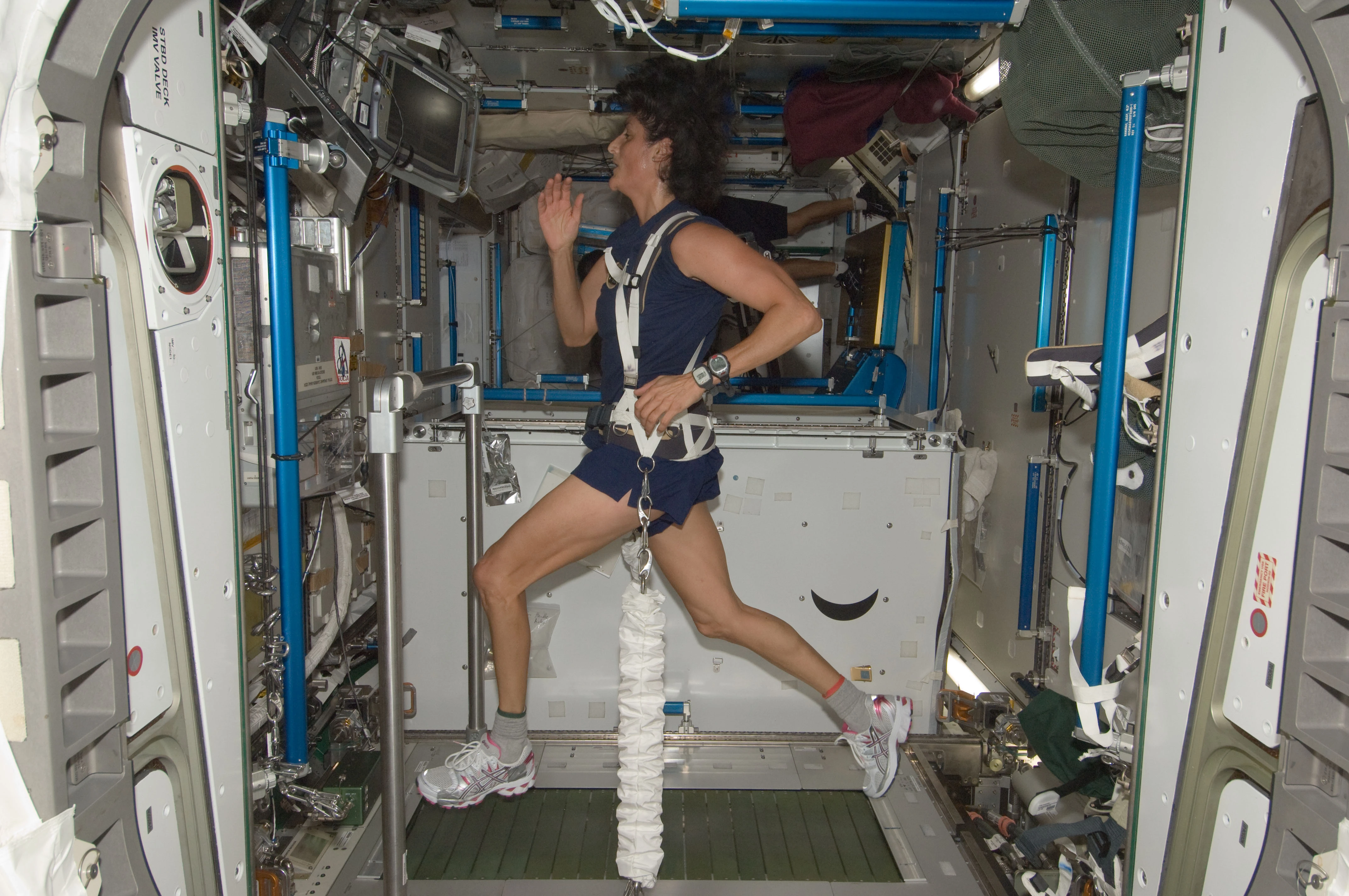
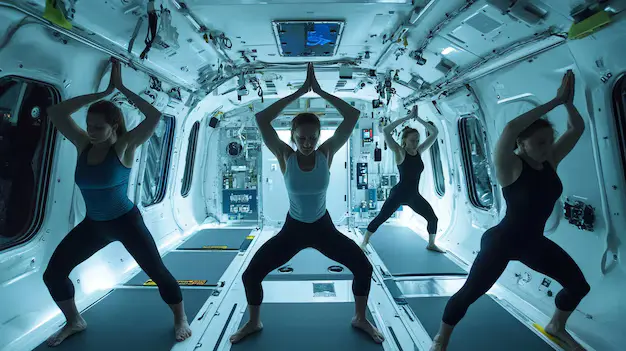
Why Microgravity Weakens Muscles and Bones
Muscle Atrophy (Wasting)
- Antigravity muscles shrink first. In orbit, the big stabilizers of the legs, spine and core aren’t needed to hold you up. Without daily activation, they atrophy (shrink and lose strength).
- Measured losses are significant. Research from NASA and ESA shows astronauts can lose 10-20 % of muscle mass in affected muscles over a six-month mission without robust countermeasures.1
- Cellular mechanisms. In microgravity, muscle cells reduce protein synthesis, increase protein breakdown, and activate “stop-growth” pathways such as myostatin.2 Calcium handling within muscle fibers also changes, disrupting contraction efficiency.
- Aging analogue. The muscle changes seen in microgravity mimic accelerated aging on Earth. Astronaut tissue samples show degeneration patterns similar to sarcopenia (age-related muscle loss).3
Bone Density Loss
- Bone resorption speeds up. In weight-bearing regions like the hips and spine, astronauts lose ~1 % of bone mineral density per month.4
- Weaker, fracture-prone skeleton. If unaddressed, this loss compromises structural integrity for re-entry or planetary operations.
- Coupled to muscle loss. Lower mechanical stress on bone reduces osteocyte signaling and diminishes myokine crosstalk that helps maintain muscle, creating a vicious cycle.
Systemic Effects
- Cardiovascular deconditioning. Without gravity pulling blood toward the feet, fluid shifts upward. Plasma volume falls and the heart becomes less efficient at pumping against gravity. This leads to fainting or low tolerance when returning to Earth or stepping onto Mars.
- Vestibular and balance adaptation. The vestibular system (inner ear organs that tell your brain which way is up) recalibrates in microgravity. Returning to gravity can feel like learning to walk again.
- Metabolic and endocrine changes. Microgravity alters mitochondrial function, hormone regulation and gene expression, making tissue maintenance less efficient.
How Space Agencies Fight These Changes
For decades, space programs have tried to simulate Earth-like loading with exercise. The International Space Station (ISS) houses several devices:
| Device / Method | What It Does | Benefits | Limits |
|---|---|---|---|
| Advanced Resistive Exercise Device (ARED) | Vacuum cylinders simulate up to 270 kg of weightlifting (squats, deadlifts, etc.). | Good for muscle and bone maintenance. | Bulky, complex, focuses on isolated movements. |
| Treadmill with Harness | Astronauts run while bungee cords pull them down to the belt. | Maintains cardiovascular fitness and some leg loading. | Unnatural loading pattern; limited multi-axis stress. |
| Cycle Ergometer | Stationary bike for aerobic training. | Helps heart/lungs. | Minimal bone loading effect. |
| Short-Radius Centrifuge Tests (on Earth) | Rotating beds or rooms to simulate gravity via spin. | Shows promise for reducing atrophy. | Not yet practical in orbit; motion sickness, size constraints. |
Artificial Gravity and Centrifuges.
A centrifuge is a rotating system that uses centrifugal force (the outward “push” you feel on a merry-go-round) to mimic gravity. Short-radius centrifuges tested on Earth show that even 30 minutes per day of spin can reduce muscle and bone loss in bed-rest subjects (a common Earth analog for spaceflight).5 MIT studies combining exercise with centrifugation found improved loading effects over exercise alone.6 But spacecraft have not yet flown a dedicated artificial-gravity exercise module because of engineering, power and motion sickness challenges.
Quick Definitions for Readers
- Microgravity: Near-weightlessness, such as on the ISS. You’re still under Earth’s gravity but in continuous free fall, so you feel weightless.
- Mechanical Unloading: Removal of normal weight-bearing forces from muscles and bones.
- Artificial Gravity: A rotating system that mimics gravity using centrifugal force.
- Centrifugal Force: The outward “push” felt when moving in a circle (like being pressed outward on a merry-go-round).
- Coriolis Effect: In a rotating space, if you move your head or limbs across the spin direction, you feel strange sideways forces that can cause disorientation or motion sickness. Any spinning habitat must minimize this.
The Current Landscape of Countermeasures & Innovations
Before proposing a new approach, it helps to map what exists: agency hardware on ISS, artificial-gravity research, and commercial stations that will host human-performance studies. This snapshot shows where the field is headed.
| Innovation | Provider / Program | What it Targets | Status / Notes |
|---|---|---|---|
| ARED (vacuum resistive training) | NASA (ISS) | Muscle & bone loading via squat/deadlift patterns | Operational hardware on ISS |
| Treadmill + Harness | NASA (ISS) | Cardio; partial vertical loading | Operational hardware on ISS |
| Cycle Ergometer | NASA/ESA (ISS) | Cardio fitness | Operational hardware on ISS |
| Gravity Loading Countermeasure Suit (GLCS) | ESA | Wearable axial loading | Studied / flight-tested concepts |
| Short-Radius Centrifuge (bed-rest analogs) | NASA/ESA, academic labs | Artificial gravity exposure | Ground studies; parabolic tests |
| AG + Exercise prototypes | MIT and collaborators | Coupling spin with strength work | Experimental; promising synergies |
| CAGE (Combined Artificial Gravity Exercise) | Research concept | AG squat/press under spin | Modeling and early testing |
| Commercial Stations | Axiom, Starlab, Orbital Reef, Vast | Habitats for long-duration crews | Planned platforms for human-factors R&D |
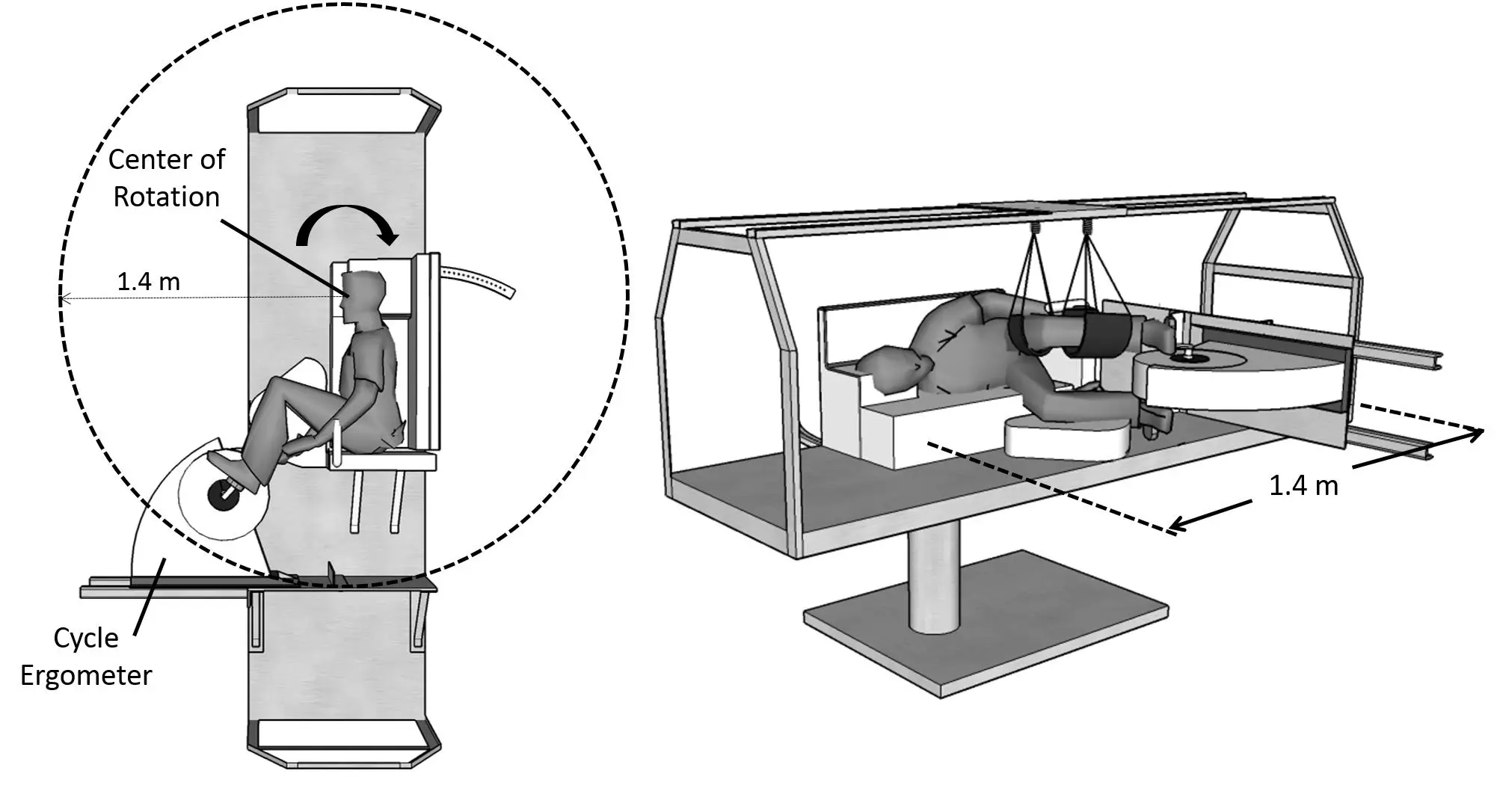
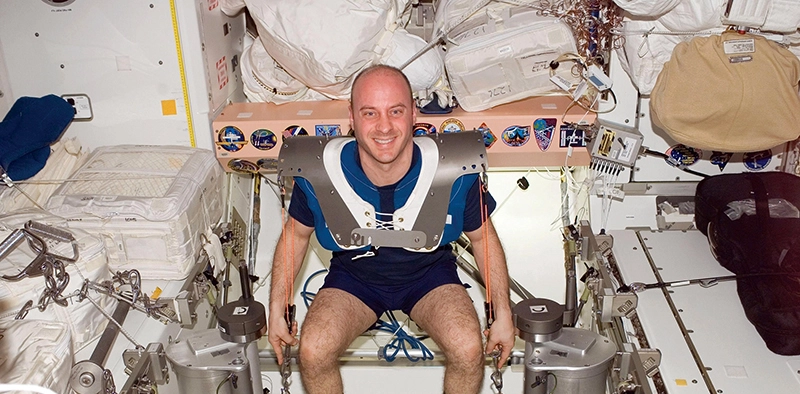
Where the Gaps Remain
- Whole-body, multi-axis loading that resembles Earth movement, not just isolated lifts.
- Integrated vestibular/balance training so crews re-adapt faster after landing.
- Compactness & habitability: equipment that doubles as a restorative daily ritual, not just a machine.
How Project Uranus is Different
Uniqueness in one sentence: adjustable artificial gravity + continuous, fluid, multi-planar movement (yoga/mobility) instead of isolated reps-so you load muscles, bones, balance, and proprioception together.
Introducing Project Uranus: Centrifuge-Assisted Mobility and Yoga
Project Uranus reframes the problem. Instead of strapping astronauts to isolated exercise machines, it provides a space for fluid, yoga-like movements under partial gravity - preserving muscles, bones, balance and mental well-being at once.
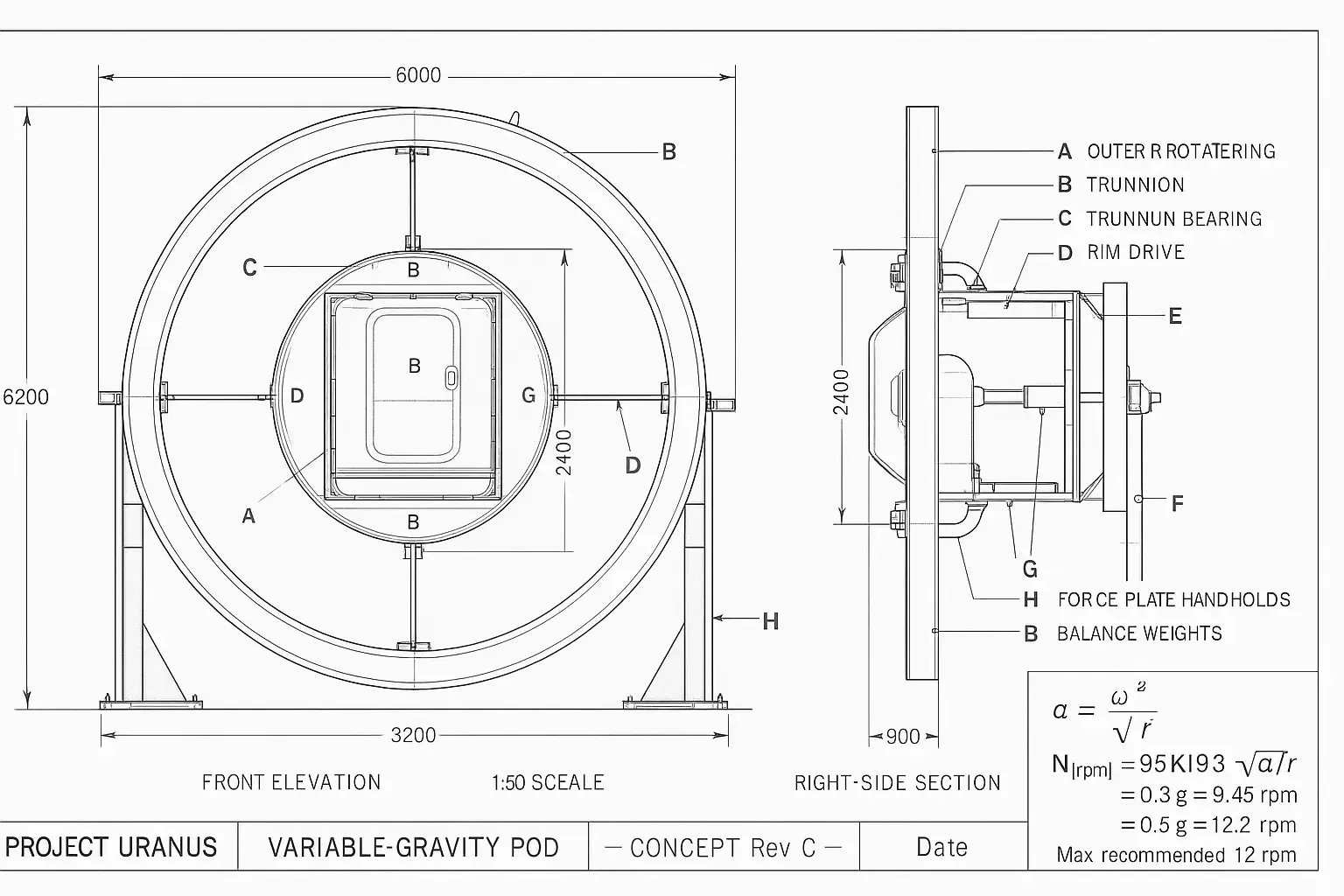
1. Variable-Gravity Pod
A compact rotating chamber generates a gentle outward force adjustable from ~0.3 g to ~0.8 g. By fine-tuning spin rate and radius, astronauts can “dial in” the load they need for a session.
- Spin rate vs. radius trade-off. Smaller radii require higher spin speeds to reach the same g-level, which can intensify Coriolis effects. Design must balance comfort and engineering feasibility.
- Ramp-up & ramp-down. Smooth acceleration reduces motion sickness and disorientation.
2. Adapted Movement Protocols
Traditional yoga poses and mobility exercises are re-engineered for partial gravity:
- Slow, controlled transitions to avoid drifting or excessive Coriolis sensations.
- Emphasis on spinal stability and core engagement - areas most vulnerable to atrophy.
- Multi-plane loading. Sequences cover flexion, rotation, lateral bending and balance, mimicking Earth’s multidirectional stresses.
3. Smart Feedback
Wearable sensors and embedded force plates monitor:
- Alignment (are joints stacked correctly?)
- Load distribution (is weight evenly spread?)
- Joint angles and muscle activation
Real-time cues (“shift weight,” “engage core”) help astronauts perform movements safely and effectively.
4. Daily Routine
- Enter pod and strap in or hold handrails.
- Spin up gradually to target g-level.
- Perform 20-30 minutes of guided mobility and strength flows.
- Spin down and exit to microgravity.
Regular sessions could reduce or even prevent musculoskeletal decline while also keeping astronauts flexible and less stressed.
Why Project Uranus Could Outperform Traditional Methods
- Whole-body loading. Instead of isolating muscles, the entire body experiences coordinated forces like on Earth.
- Efficiency. One session trains strength, flexibility, balance and coordination.
- Neural & proprioceptive preservation. Movement challenges help maintain vestibular and balance systems, making return to gravity smoother.
- Behavioral comfort. Movement-based training may be more engaging than repetitive strength work, reducing fatigue or noncompliance.
A related concept, the CAGE system (Combined Artificial Gravity Exercise) combines squat exercise with artificial gravity. Modeling suggests coupling artificial gravity with exercise may yield superior musculoskeletal preservation than either alone.7 Project Uranus builds on this by using fluid, multi-axis movement instead of isolated reps.
Engineering and Testing Challenges
- Motion sickness and Coriolis effects. Rapid head or limb movements across the spin direction can cause disorientation. Mitigation methods include smooth spin ramps, limiting head motion, and designing modules with optimized radius.
- Size and mass constraints. A centrifuge large enough for comfortable movement but small enough for spacecraft is a major engineering task.
- Power and control. Spin control, stabilization and sensor systems require energy and robust control algorithms.
- Protocol validation. Ground analog trials, parabolic flights and eventually orbital tests must verify efficacy, safety and crew adherence.
The Path Forward
| Stage | Goal |
|---|---|
| Ground Modeling | Define optimal spin rates, radii and loading patterns using human biomechanical models. |
| Earth Prototypes | Build small rotating rigs, test adapted movement sequences with athletes or analog astronauts. |
| Analog & Flight Tests | Conduct parabolic flight trials and integrate a prototype into ISS or commercial station modules. |
| Operational Deployment | Scale for deep-space habitats, with automated session guidance and health monitoring. |
With successful development, Project Uranus could complement or replace existing countermeasures and become a cornerstone of long-duration human spaceflight health.
References
- NASA: Counteracting Bone and Muscle Loss in Microgravity
- PubMed: Effects of Microgravity on Muscle Cells
- ScienceDirect: Muscle Degeneration Under Microgravity
- Wikipedia: Spaceflight Osteopenia
- NASA: AGBRESA Bed-Rest Study
- MIT News: Exercise and Artificial Gravity in Space
- ScienceDirect: Combined Artificial Gravity Exercise (CAGE) System
About Me
I’m Rayan - a student who loves swimming, computer science, and physics. Project Uranus blends those passions: movement and recovery from swimming, systems thinking from CS, and the mechanics of spin, load, and balance from physics. I’m exploring how partial-gravity movement can keep astronauts strong, coordinated, and ready for the moment the hatch opens on the Moon or Mars.
- Interests: biomechanics, human-computer interaction for coaching, and compact hardware that crews actually want to use every day.
- What I’m building next: a small Earth prototype that couples a rotating platform with pose-tracking to test flow sequences.